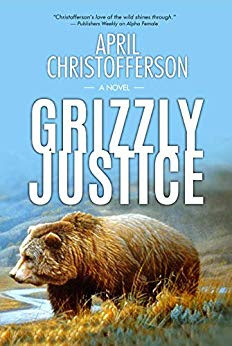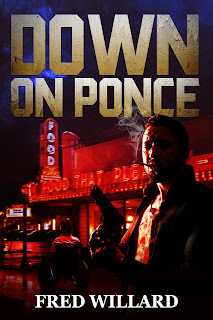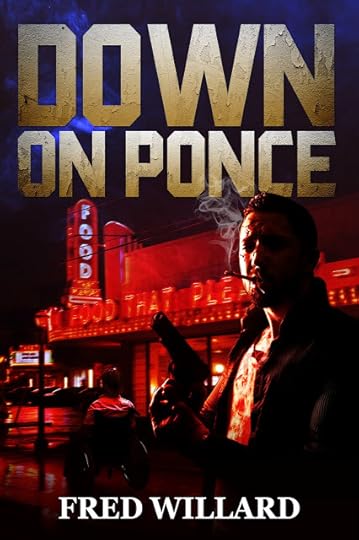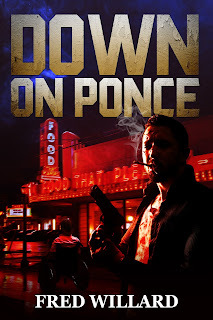Kenneth Atchity's Blog, page 20
May 1, 2024
Ken's Story Merchant Book Recommendation: Grizzly Justice by April Christofferson
FREE THIS WEEK ON AMAZON

AVAILABLE ON AMAZON
When Yellowstone backcountry ranger Will McCarroll is fired for breaking the rules one time too many, he disappears into the backcountry to continue his decades-long mission of protecting the park’s wildlife. Will is hell bent on saving a wounded grizzly bear whose fate is all but certain: euthanasia.

AVAILABLE ON AMAZON
When Yellowstone backcountry ranger Will McCarroll is fired for breaking the rules one time too many, he disappears into the backcountry to continue his decades-long mission of protecting the park’s wildlife. Will is hell bent on saving a wounded grizzly bear whose fate is all but certain: euthanasia.
Published on May 01, 2024 00:00
April 29, 2024
Story Merchant E- Book Deal: FREE April 29 - May 3rd Grizzly Justice by April Christofferson

Available on Amazon
When Yellowstone backcountry ranger Will McCarroll is fired for breaking the rules one time too many, he disappears into the backcountry to continue his decades-long mission of protecting the park’s wildlife. Will is hell bent on saving a wounded grizzly bear whose fate is all but certain: euthanasia.
In his quest, Will stumbles onto a secret meeting of the Alliance, a political movement determined—at any cost—to force the transfer of public lands into state hands. Blackfeet wolverine biologist Johnny Yellow Kidney has taken a forced hiatus from his work in Glacier National Park to head a project born of a high-profile journalist’s loss from a highway tragedy. The goal: to construct safe highway crossings for Montana’s wildlife. Once again, Johnny and Will’s paths cross, not only through both men’s romantic connection to Yellowstone Magistrate Judge Annie Peacock, but also in each man’s race to save the two- and four-leggeds they’ve sworn to protect. Time is running out in Yellowstone Country—and for Will, Johnny, and those they’ve dedicated their careers to defending, the stakes couldn’t be higher.
“A gorgeous book. Grizzly Justice is a riveting read, the majesty and magic of its landscapes and wildlife illuminating every page. I couldn’t put the book down and closed the last page with a deep sense of gratitude for our national parks and profound respect for those who fight to protect them. This book will bring transformational awareness to its readers. It certainly did for me.”
-Ruth Wariner New York Times bestselling author of The Sound of Gravel.
“April Christofferson weaves together her knowledge of the cadences of the natural world, the complexity of behavior that enables injustice, the redemption that passion provides to individual initiative, and the foibles of the human heart.”
-Jeff Hull, bestselling author of Broken Field: A Novel
“Guaranteed to make any reader late for dinner, or even breakfast.”
-Booklist on Clinical Trial
Published on April 29, 2024 00:00
April 26, 2024
TRULY EXCELLENT WRITING: The Ghosts of Ponce De Leon Park by Fred Willard


Part Three
He woke up in the middle of the night breaking a fever. There was a bright full moon.
"I got to pee bad, man, and I can't move my legs," he said. "I need help getting up.”
Bob didn't answer so he pushed himself up a little bit on an elbow and saw the ground where Bob had been sleeping and had crushed the kudzu, but Bob and his bedroll were gone. Del felt for his money stash and it was gone, too. At least he left one of the pints.
There wasn't nothing he could do but lie there until somebody came along to help. He held the pee as long as he could then wet the bed. It felt uncomfortable as it soaked his pants and ran up his back. He didn't think he could go back to sleep, but that wasn't the worst part. Something much more frightening was happening because time was messing up somehow and he was also back in his parents’ little shack they had rented in West Atlanta when he was nine years old.
"I was thinking about taking the boy to a ball game," his father said.
Del pretended he wasn't paying attention but he hoped his mother would say yes. She was the one who had a job, and she always watched every penny she made. That's what his parents always fought about.
"I guess we ought to do something for him," his mother said. She walked back to her bedroom, where she kept her money, and closed the door so nobody could hear her hiding place. When she came out she handed a couple folded dollar bills to his father, and some change, too.
"Why don't y'all get yourself a hot dog? That way I don't have to cook nothing for you tonight."
She went back to her room and laid down. She worked so much she was always tired. Some days she went to bed as soon as she got home from work.
After a while his father said, "Okay, boy, it's time to go to that ball game."
He followed his father up to the trolley stop, trying to keep up with his funny bobbing walk. They sat on a hard bench for a few minutes till the trolley came.
"Mr. Driver, I need a transfer for me and my boy." He said it like they always did things together.
The driver tore off two scraps of paper, and handed them to him, and then his father made a big to do about handing one to Del.
"Now you hold onto this, Son. It's what makes you able to ride the second trolley."
They both sat down.
"I like this sideways seat the best," his father explained.
"Me too, " Del agreed.
After a few minutes his father pulled the cord that rang the bell and said, "Time to get off."
They were at another bus stop and Del sat on a bench like the other one.
"Now you sit here, till I get back. No matter what happens, just stay there."
He crossed the street and went in a liquor store and when he came out Del could see a bottle stuck in his front pants pocket. When he sat next to Del he took it out, and held it to his lips and swallowed three or four times.
"Here. You want some?"
He handed it to Del who took a sip but thought it tasted sour, like puke. He pretended to like it, though.
"Here comes the bus." His father put the bottle back in his pants.
"They don't like you to drink this stuff on the bus," he father explained.
Once they got on it seemed like they were at a party.
"Anybody going to see the Crackers?" his father asked.
A bunch of people laughed like his father had told a joke.
"Seems like most of us are," a woman said.
"Have a seat, son."
He sat Del down in the sideways seat, then walked back four or five rows to where there was a bunch of men sitting. He said something, they laughed, and a couple of them looked up toward the driver, then the bottle came out and they were passing it around.
Del looked out the window and watched the people on the street until they stopped next to this big brick building with a tower on top like a castle.
"That's the Sears and Roebuck."
A woman sitting next to him said this when she saw him looking at the building.
"Everybody off the bus," his father said. The men with him laughed like this was pretty funny.
People were already starting to line up to buy tickets, so his father ran ahead and bought two seats in the white bleachers. They went up this ramp into the park and he followed his father and the other men under the wooden seats to a refreshment stand where a man was cooking hot dogs on a grill.
Dell asked, "You going to get us some hot dogs, daddy?"
"Don't have no money left," he said. "But wait a minute here. I got something in my pocket."
He reached in his pocket and pulled out his white handkerchief. He bent down on one knee, and laid it out like a neat square, then stepped back and started doing a little dance like a buck and wing and giving out these little yelps.
He was pretty good at it, but Del didn't like to watch.
Pretty soon a crowd had gathered and people were dropping nickels and dimes, even a few quarters on the handkerchief.
"Thank you very much, folks." his father said. He scooped up the money and handed Del a quarter.
"You keep this in case you need it. Don't spend it on food or nothing. Just hold onto it. Now go on up and get us our seats and I'll be along in a little while."
The men from the bus had gathered around his father again and Del knew he wanted to drink with them, so he went to get their seats in the bleachers. A boy his own age tried to sit down next to him, but he held his hand out over the seat and said, "My daddy's going to be sitting there," so the boy moved over a space.
Pretty soon the teams took to the field and everybody cheered. Del didn't know much that was going on but he acted like he did, so nobody would think he was stupid. He didn't know how to play ball. His parents moved around so he never really got to have many friends and the few boys he knew didn't have the equipment. Still, it was real beautiful to watch. The lights made the field seem bright green and the uniforms stuck out like a cartoon in the newspaper. Out in the distance there was this dirt bank covered with kudzu and a big magnolia tree and over to the right, a railroad track. It didn't look like how he'd imagined a ballpark, but he liked it.
He actually started figuring out the game, at least part of it, and he'd get excited with every pitch, and cheer with the crowd when the players from Birmingham would swing at a pitch and miss.
He was having fun until he figured out that his father wasn't coming to his seat, and then he only watched the game because he knew he ought to be having fun since he probably wasn't going to get to come back.
The Crackers won. As the crowd left, he didn't see his father and he knew he wasn't here. In his pocket, he felt the quarter and wondered if this was the time he was supposed to save the money for, or if there would be another one. Finally he decided this must be the time, because spending it was the only way he was going to get home.
"I'd like a transfer, Mr. Driver." he said
The man gave him a funny look, but handed him the transfer.
Del was pretty sure he could spot the street where he lived, but he wasn't too sure about the stop by the liquor store, so he sat in the sideways seat twisted around with his face pressed against the window. It turned out to be easy to see because of the lights, so he rang the bell and got off the trolley.
He was quiet going in the house. He was starving and got a piece of bread. He hoped his mother wouldn't notice and get mad.
"That you boy?” she called from the bedroom.
"Yes ma'am."
"Is your father with you?"
"No ma'am, he ain't."
"I should have known," she said. "He don't care nothing about you. He just wanted the money so he could get a drink."
"He won't be coming back neither," she said. "I told him the next time he took to drinking he couldn't come back, but sometimes that man needs a drink so bad he'd trade his whole life for it."
 AVAILABLE ON AMAZON
AVAILABLE ON AMAZONA Note From the Editor
There is, in every city of some size, "a street of appetites" — a place where people with hungers congregate, a street where things happen in dark places. In Atlanta, The Bitter Southerner’s hometown, that street has always been Ponce de Leon Avenue. Ponce, as we call it, is home to the legendary Clermont Lounge, where strippers whose average age is 46.5 shake their moneymakers, and the Majestic Diner, which has been serving hangover prevention and cures 24/7 since 1929. Ponce always begs to be the setting of a novel. Back in 1997, an Atlanta writer named Fred Willard delivered a great one. “Down on Ponce” was hard-boiled crime fiction, solidly in the tradition of Raymond Chandler and Jim Thompson. “Down on Ponce” permanently planted itself in my brain. I was 36 years old when it came out, and I’ve gone back to reread it several times. For a guy like me, who loves crime fiction written with verve and feistiness, “Down on Ponce” was just the ticket, particularly because I knew its setting like the back of my hand.But in the last decade or so, the literary world hasn't seen much of Fred Willard's work. Then a few weeks ago, out of the blue, Willard sent The Bitter Southerner a short story.This made me a happy guy — happier still because his story is set once again on Ponce, Atlanta's “street of appetites,” as Willard so aptly describes it here. You'll experience two Ponces in this story. One is the Ponce of the 1990s, when the kudzu-shrouded, long-unused railroad tracks that bisect the street were still the home of much nefarious activity. Today, those tracks are a pedestrian trail called the BeltLine. The other is the Ponce of the mid-20th century, when the Negro League Atlanta Black Crackers and the minor-league Atlanta Crackers shared Ponce de Leon Park, an old baseball field now long gone. Today, a Whole Foods sits about where center field was. A crime does occur in this story, and the writing is as blunt as the best crime fiction, but in “The Ghosts of Ponce de Leon Park,” Willard is now exploring different characters with different hungers — the homeless. We meet Bob and Del soon after they arrive in Atlanta, having come to the city after Del “just wore out my welcome too many places” in Nashville.Speaking of welcomes, we’re happy to welcome one of our favorites, Fred Willard, to the pages of The Bitter Southerner.— Chuck Reece
Repost from the Bitter Southerner
Published on April 26, 2024 00:00
April 24, 2024
What They're Saying About Fred Willard's Down on Ponce

Down on Ponce, by Fred Willard
The Ponce of the title is Ponce de Leon Avenue in Atlanta, Georgia, and is, according to an Author's Note, "a haven for the homeless…
The Ponce of the title is Ponce de Leon Avenue in Atlanta, Georgia, and is, according to an Author's Note, "a haven for the homeless, the lawless and the restless". Qualifying on all counts is retired marijuana smuggler Sam Fuller, who gets involved in the disintegrating operations of mob boss Billy "Dong" Chandler. Fuller is aware that Chandler has a huge cache of money hidden somewhere - if one were to go by his nickname, perhaps the front of his trousers might be the first place to look - and decides to round up a crowd of the usual suspects in order to steal it. The result is a highly engaging comedy-thriller which never lets up until the last frenetic page.
via Irish Times
Down on Ponce
Fred Willard
This is a real rollercoaster of a book - I couldn't put it down. It's easy to read, full of action, and there's no knowing where it's going next. The characters are unusual - to put it mildly - but totally believable. I was with them all the way with a smile on my face, even through the sometimes bloody violence. Not for the fainthearted, but it will certainly brighten a dreary day.
Excerpt:
As soon as we stopped, Bob jumped out and stripped off his clothes. Then he joined Charley at the tailgate and they slid out the stretcher. Bob lifted Lloyd forward and was holding him, getting ready to find him a comfortable spot to watch the action, when Charley unzipped the body bag.
The first thing Vogel saw was a huge naked man with a stocking on his head, but half his face obviously missing, standing in the red light holding another man with a stocking on his head with amputated legs.
He screamed in total primal terror, then fell silent.
via whichbook
If you like Elmore Leonard, you have to read Fred Willard‘s Down on Ponce. This is not Fred Willard, the actor, but another Fred Willard, a journalist from Atlanta. Down on Ponce is a caper story, with a lot of plot to go around, but the characters and the dialog are what put it on the list. Some of the funniest dialog I’ve read in years, and one character in particular, Charlie, an ex-con hearse driver who refers to himself as Death’s Representative in Atlanta and who likes to attend anti-abortion rallies for the entertainment quality is a true gem. My favorite of Charlie’s lines, “That was one of your better fetus flings, even if I had to do it myself.” The grim underbelly of Atlanta never looked so good. Down on Ponce is published by a small publisher, so you might have to work a bit to find it, but it’s worth it.
via Christopher Moore
Published on April 24, 2024 00:00
April 22, 2024
Story Merchant e-Book Deal #FREE April 22 - 26 Fred Willard's Down on Ponce

AVAILABLE ON AMAZON
SAM FULLER, a man who lives on the edge of the law, is offered $50,000 to murder a man’s wife. Instead of committing the crime, he warns the wife and runs with the money. The next day Sam’s trailer is set afire and his friend JIMMY is killed; Sam knows he was the intended victim.Sam goes underground, hiding out in the Ponce de Leon section of downtown Atlanta. He befriends CHARLIE SHELNUT, a late 20s rockabilly undertaker, and several misfit street cons who trace Jimmy’s death to a Dixie Mob money-laundering scheme. Sam devises an elaborate plan to make the murderers pay, literally -- he’ll rip off their drug profits.Sam’s crew soon find themselves in the middle of a turf war between the Dixie mob and a disgraced ex-district attorney whose own drug abuse has pulled him into the money laundering trade. The climax of this riveting, often hilarious tale comes in an explosive confrontation as Sam and his crew exact final retribution for the killing of Sam’s friend.

A former newspaper photographer Fred Willard is known as the master of "Cracker Noir," his books boil with smarmy characters and their bizarre antics. Down on Ponce is hard-boiled crime fiction, solidly in the tradition of Raymond Chandler and Jim Thompson.
Published on April 22, 2024 00:00
April 19, 2024
TRULY EXCELLENT WRITING: The Ghosts of Ponce De Leon Park by Fred Willard

Part Two

When it came down to it, Del didn't know jack-shit about Bob. He thought Bob could just as easy take off with the money and not come back, buy himself a decent dinner and keep all the wine for himself. He had the look of someone who knew how to take care of himself, all right. His jeans, work shirt and heavy shoes were a lot newer than Del’s, whose clothes looked like they were about to rot off. Not that he cared anymore, but Del thought they smelled like it too.
At the shelter in Nashville, Bob had got hung with the name Normal Bob. He wasn't so damn normal, but he had the good luck to show up after Crazy Bob who got his instructions from a dog named Tick that nobody else could see. Mostly the dog told him to howl. So Bob became Normal Bob to tell him apart from Crazy Bob.
Normal Bob was going back to Atlanta so Del planned to tag along. Del had a little stash of money and Normal knew the city so it seemed like a good partnership.
Del laid out in his bedroll and put his head on his little bag of clothes and watched the puffy white clouds drift across the early evening sky. In a little while, the night would unzip its bag of tricks and spill the predators into the hundreds of pockets of darkness along this street of appetites, and by then Del hoped to be fed, drunk and sleeping unnoticed among the weeds.
Now that he'd got the weight off his legs, he noticed he was getting the shakes in his hands, but there wasn't nothing he could do about it till Bob got back with the wine. He lay like this about an hour, till twilight, when he heard a man approaching, looked up and saw Bob carrying a couple of sacks.
"I got us both a Chubby Decker Plate."
He handed Del a pint bottle. Del broke the seal, and took three or four gulps, and fought to keep them down. He didn't want to waste any of it.
"You going to eat anything with that?" Bob asked.
"First things first," Del said.
"You shouldn't have made this trip. It was too much for you," Bob said.
"Had to leave Nashville."
"It must have been big trouble," Bob said.
"No, I just wore out my welcome too many places. Life was getting too hard."
"Well, a lot of little trouble can be just as bad as big trouble," Bob said. "Tomorrow morning we can head up to St. Luke’s for breakfast. Talk to the guys there. See what's going on."
"I don't know if I can make it," Del said. "I don't think I'm going to be able to walk at all."
"I can call the Grady wagon then, they can take you to the hospital."
“I'm afraid they might have to cut my legs off."
Bob tried to change the subject.
"This place we're sitting is historic. It's the back end of the old Ponce de Leon Baseball Park. That magnolia tree would have been at dead center field. The Atlanta Crackers used to play here. I came to the games with my old man. They tore the place down when they built the new stadium for the Braves. Turned it into this parking lot."
"I never liked this place none," Del said.
"You been here then?"
"I lived in Atlanta a couple months when I was a kid. I came here with my father once," Del said. "What do they call that building across the street?"
"That would be the old Sears and Roebuck. It's got city offices now, so they call it City Hall East."
"I remember the Sears and Roebuck, you got of the trolley and walked across the street to the park."
"That's right, man, they still had the old electric trolleys when the Crackers played here."
"I never had no luck here. We shouldn't have stopped here."
"Hell, you were the one who wanted to stop, Del. You said your legs were bad. You never should have left Nashville with your legs like that."
"I know that, now," Del said. The memory of the old ball park pinned him to the ground like a stack of cement blocks on his chest.
 AVAILABLE ON AMAZON
AVAILABLE ON AMAZONA Note From the Editor
There is, in every city of some size, "a street of appetites" — a place where people with hungers congregate, a street where things happen in dark places. In Atlanta, The Bitter Southerner’s hometown, that street has always been Ponce de Leon Avenue. Ponce, as we call it, is home to the legendary Clermont Lounge, where strippers whose average age is 46.5 shake their moneymakers, and the Majestic Diner, which has been serving hangover prevention and cures 24/7 since 1929. Ponce always begs to be the setting of a novel. Back in 1997, an Atlanta writer named Fred Willard delivered a great one. “Down on Ponce” was hard-boiled crime fiction, solidly in the tradition of Raymond Chandler and Jim Thompson. “Down on Ponce” permanently planted itself in my brain. I was 36 years old when it came out, and I’ve gone back to reread it several times. For a guy like me, who loves crime fiction written with verve and feistiness, “Down on Ponce” was just the ticket, particularly because I knew its setting like the back of my hand.But in the last decade or so, the literary world hasn't seen much of Fred Willard's work. Then a few weeks ago, out of the blue, Willard sent The Bitter Southerner a short story.This made me a happy guy — happier still because his story is set once again on Ponce, Atlanta's “street of appetites,” as Willard so aptly describes it here. You'll experience two Ponces in this story. One is the Ponce of the 1990s, when the kudzu-shrouded, long-unused railroad tracks that bisect the street were still the home of much nefarious activity. Today, those tracks are a pedestrian trail called the BeltLine. The other is the Ponce of the mid-20th century, when the Negro League Atlanta Black Crackers and the minor-league Atlanta Crackers shared Ponce de Leon Park, an old baseball field now long gone. Today, a Whole Foods sits about where center field was. A crime does occur in this story, and the writing is as blunt as the best crime fiction, but in “The Ghosts of Ponce de Leon Park,” Willard is now exploring different characters with different hungers — the homeless. We meet Bob and Del soon after they arrive in Atlanta, having come to the city after Del “just wore out my welcome too many places” in Nashville.Speaking of welcomes, we’re happy to welcome one of our favorites, Fred Willard, to the pages of The Bitter Southerner.— Chuck Reece
Repost from the Bitter Southerner
Published on April 19, 2024 00:00
April 17, 2024
Night Owl Reviews Story Merchant Books' Dragon Heart by Linda A. Malcor
 AVAILABLE ON AMAZONDragon HeartDragonlords of DumnoniaThis is a novel that took my breath and imagination away. Seldom do I enjoy a novel to the point I couldn't put it down for a moment. From the start there is a synergistic energy that keeps the storyline in place at all times. For once I wished I could ride a dragon! This story is intended for young adults, but I say it's for everyone. The characters were fresh and eager. The plot is an old one, but with many twists to keep the reader off their feet.
AVAILABLE ON AMAZONDragon HeartDragonlords of DumnoniaThis is a novel that took my breath and imagination away. Seldom do I enjoy a novel to the point I couldn't put it down for a moment. From the start there is a synergistic energy that keeps the storyline in place at all times. For once I wished I could ride a dragon! This story is intended for young adults, but I say it's for everyone. The characters were fresh and eager. The plot is an old one, but with many twists to keep the reader off their feet.There is a scrap of a boy who dreams of riding a dragon, but he feels his dreams are far away, especially in the land of Drumnonia where there are dragons, riders, AND demons, gods, and elves. In the end, he becomes a dragon rider, and not just an ordinary rider either: he is the Dragonheart!
A dragonheart is a rider who is part dragon and part Drumnonian, and they are rare. They also do many spectacular things in their lifetimes, but this youngster, Shashtah, hasn't begun his journey to where the spectacular become normal. He picks as his first dragon an ancient who knows her time is up in five years. She is a dragon to teach Shashtah what he needs to learn as he has a mission too important to wait for him to learn all he needs to know prior to leaving.
This story takes the reader into the beginning moments of one young man's dreams and shows how incredible his rise to stardom is. There are many adventures and the author packs this story in so tight, it's a wonder if there is any more Shashtah can do in another novel. I'm very excited and hopeful that there is another novel with Shashtah coming soon.
Book Blurb for Dragon HeartTHE WIZARDS . . .
Life on Centuria used to make sense. Beings with special powers went to the School of Corin to learn how to control them. The more they learned, the more powerful they became. And the greatest Wizard of them all was the White Wolf.
THE WAR . . .
During their quests for knowledge, the Wizards accidentally opened a door to another dimension, where the Mirari lived. Beings of Light, the Mirari banished one of their rebels to Centuria where he became known as the Dark One. The Dark One took his anger out on the unprotected world, and the Wizards did not have the power to stop him. So the Mirari sent two of their own, the Winged Warrior Criton and the Elven King Farador to help. Their magic did not work properly on Centuria, though, and all they could do was keep the Dark One’s forces at bay.
THE DRAGONS . . .
An experiment begun by the Wizard Corin, the Bronze Dragons and the Dumnonians who care for them control a land rich in sand and so poor in everything else that not even the Dark One wants it. Caravans trade for supplies in the wealthy land of the Dragonslayers, Daethia, which supply the Dragons and Dumnonians with barely enough provisions to keep them alive.
THE PROPHET . . .
A caravaneer, Shashtah wants to Bond with one of the Bronzes and help the Dragonriders of Dumnonia carry “Eternal Death to the Dark One!” When demons capture and torture Shashtah, his powers awaken at the wrong time and out of control. The Dragons suddenly find themselves with a very dangerous, untrained Prophet rather than what they had really bred for: a Dragonheart.
Published on April 17, 2024 00:00
April 15, 2024
Story Merchant e-book Deals #FREE April 15 - April 19 - Linda Malcor's Dragon Heart

AVAILBLE ON AMAZON
Shashtah, a veteran desert warrior struggles to become one of the legendary Dragonriders of Dumnonia. Except the gods have other plans. He winds up Bonded to the wrong Dragon and searching for a Wizard known as the White Wolf, who doesn’t want to be found, in a world filled with demons, elves, monsters and other magical things he’d really rather not think about. As if that weren’t enough, the chief god decides to use him as a Prophet, which promises to be a very poor career choice since Shashtah is also special kind of half-Dragon, one known as a Dragonheart.
Published on April 15, 2024 00:00
April 12, 2024
TRULY EXCELLENT WRITING: The Ghosts of Ponce De Leon Park by Fred Willard
Part One
 “We can thumb some more or just walk down the railroad tracks to Ponce," Bob said."My legs don't feel so good," Del said. "The doctors at the clinic said my circulation is bad.""I know, man. You already told me. Maybe walking will get your circulation going.""Maybe so. I don't know about that. I just know my legs don't feel good."Del looked down the rail bed. A tree line on either side hid it from the apartments and the shopping center and as the line curved gently in the distance to the left it also hid the destination."How far is it," he asked."Maybe a mile.""I guess we might as well walk it. We might stand around that long waiting for a ride."They walked between the rails matching strides to the wooden ties."I don't know if I can keep this up," Del said."We can slow down.""It ain't the speed it's the reach.""The gravel's harder.""I'm going to walk over to the side on the dirt," Del said. He stepped over to the worn path on the edge of the right of way."It's softer here," he said."That's your problem," Bob said. "You're too damn soft. It's like you never worked.""I worked plenty.""Down there is where the snakes are," Bob said."I don't see any damn snakes."Del was slowly falling behind Bob's strides on the railroad ties."Hold on. What's the damn hurry?""You're in bad shape.""It's the circulation. The doctors said I might get gangrene. Then they'd have to cut my legs off.""That's the other thing, your circulation. I can tell you hadn't been working, not without any circulation. So where did you get that stash of money?""I ain't got that much.""But where did you get it? You been sucking dicks?""Why did you go and say something like that?""Well have you?""Hell, no.""Where did you get the money, then?""Sold blood.""No wonder you can't walk.""You never sold blood?""I never been in bad shape like you are.""So if I'm in bad shape, why don't you just slow down? It ain't polite running off like that.""I'll slow down. but this cut-through scares the hell out of me sometimes.""Why's that?""All sorts of bad shit happens back here. The skinheads catch you and they kick your ass. They killed a couple homeless along these tracks. Stomped this one guy till his heart exploded.""Now you're frightening me. What do they do — hide in the trees till you come by?""No. They just use it as a cut-through. They walk over from Little Five Points, go up to Piedmont Park to beat queers. Keep your eyes open. We see anybody, we can get off the tracks and hide. I just don't like thinking about it.""You wouldn't run off and leave me, if you saw the skinheads coming, would you?""I don't know, man. There wouldn't be much point in my sticking around for an ass-whipping if I couldn't do nothing, would there?""I'll try to walk faster, but my legs are killing me. If we see some skinheads, help me hide in the trees before you run off.""I'll do that, Del."The track had been following a gentle curve, but as it straightened they could see Ponce de Leon Avenue ahead."It isn't that much further," Bob said.They didn't talk as they tried to make time. Del's legs felt raw. They were swelling and he walked with them stiff in a fast shuffle so he could keep up. He counted steps to help the time pass. When they were almost to Ponce he said, "My legs are no good, I got to lay down.""We farted around so long we can't get nothing at the Open Door or St. Luke’s," Bob said. "I guess we might as well spend the night in this kudzu field. You want to buy us both a dinner since we missed it because of your damn circulation.""You can get us dinner and a couple pints of sherry," Del said.They walked to the kudzu-covered field to the right of the tracks, and found a little depression where they wouldn't be as visible and unrolled their bedrolls. Del pulled some money out of his stash and handed it to Bob."Why don't you take a water bottle.""Okay, I got to go to Green's then up to the Zesto, so it's going to take me some time, so just hang on.""I ain't going nowhere," Del said.
“We can thumb some more or just walk down the railroad tracks to Ponce," Bob said."My legs don't feel so good," Del said. "The doctors at the clinic said my circulation is bad.""I know, man. You already told me. Maybe walking will get your circulation going.""Maybe so. I don't know about that. I just know my legs don't feel good."Del looked down the rail bed. A tree line on either side hid it from the apartments and the shopping center and as the line curved gently in the distance to the left it also hid the destination."How far is it," he asked."Maybe a mile.""I guess we might as well walk it. We might stand around that long waiting for a ride."They walked between the rails matching strides to the wooden ties."I don't know if I can keep this up," Del said."We can slow down.""It ain't the speed it's the reach.""The gravel's harder.""I'm going to walk over to the side on the dirt," Del said. He stepped over to the worn path on the edge of the right of way."It's softer here," he said."That's your problem," Bob said. "You're too damn soft. It's like you never worked.""I worked plenty.""Down there is where the snakes are," Bob said."I don't see any damn snakes."Del was slowly falling behind Bob's strides on the railroad ties."Hold on. What's the damn hurry?""You're in bad shape.""It's the circulation. The doctors said I might get gangrene. Then they'd have to cut my legs off.""That's the other thing, your circulation. I can tell you hadn't been working, not without any circulation. So where did you get that stash of money?""I ain't got that much.""But where did you get it? You been sucking dicks?""Why did you go and say something like that?""Well have you?""Hell, no.""Where did you get the money, then?""Sold blood.""No wonder you can't walk.""You never sold blood?""I never been in bad shape like you are.""So if I'm in bad shape, why don't you just slow down? It ain't polite running off like that.""I'll slow down. but this cut-through scares the hell out of me sometimes.""Why's that?""All sorts of bad shit happens back here. The skinheads catch you and they kick your ass. They killed a couple homeless along these tracks. Stomped this one guy till his heart exploded.""Now you're frightening me. What do they do — hide in the trees till you come by?""No. They just use it as a cut-through. They walk over from Little Five Points, go up to Piedmont Park to beat queers. Keep your eyes open. We see anybody, we can get off the tracks and hide. I just don't like thinking about it.""You wouldn't run off and leave me, if you saw the skinheads coming, would you?""I don't know, man. There wouldn't be much point in my sticking around for an ass-whipping if I couldn't do nothing, would there?""I'll try to walk faster, but my legs are killing me. If we see some skinheads, help me hide in the trees before you run off.""I'll do that, Del."The track had been following a gentle curve, but as it straightened they could see Ponce de Leon Avenue ahead."It isn't that much further," Bob said.They didn't talk as they tried to make time. Del's legs felt raw. They were swelling and he walked with them stiff in a fast shuffle so he could keep up. He counted steps to help the time pass. When they were almost to Ponce he said, "My legs are no good, I got to lay down.""We farted around so long we can't get nothing at the Open Door or St. Luke’s," Bob said. "I guess we might as well spend the night in this kudzu field. You want to buy us both a dinner since we missed it because of your damn circulation.""You can get us dinner and a couple pints of sherry," Del said.They walked to the kudzu-covered field to the right of the tracks, and found a little depression where they wouldn't be as visible and unrolled their bedrolls. Del pulled some money out of his stash and handed it to Bob."Why don't you take a water bottle.""Okay, I got to go to Green's then up to the Zesto, so it's going to take me some time, so just hang on.""I ain't going nowhere," Del said.
A Note From the Editor
There is, in every city of some size, "a street of appetites" — a place where people with hungers congregate, a street where things happen in dark places. In Atlanta, The Bitter Southerner’s hometown, that street has always been Ponce de Leon Avenue. Ponce, as we call it, is home to the legendary Clermont Lounge, where strippers whose average age is 46.5 shake their moneymakers, and the Majestic Diner, which has been serving hangover prevention and cures 24/7 since 1929. Ponce always begs to be the setting of a novel. Back in 1997, an Atlanta writer named Fred Willard delivered a great one. “Down on Ponce” was hard-boiled crime fiction, solidly in the tradition of Raymond Chandler and Jim Thompson. “Down on Ponce” permanently planted itself in my brain. I was 36 years old when it came out, and I’ve gone back to reread it several times. For a guy like me, who loves crime fiction written with verve and feistiness, “Down on Ponce” was just the ticket, particularly because I knew its setting like the back of my hand.But in the last decade or so, the literary world hasn't seen much of Fred Willard's work. Then a few weeks ago, out of the blue, Willard sent The Bitter Southerner a short story.This made me a happy guy — happier still because his story is set once again on Ponce, Atlanta's “street of appetites,” as Willard so aptly describes it here. You'll experience two Ponces in this story. One is the Ponce of the 1990s, when the kudzu-shrouded, long-unused railroad tracks that bisect the street were still the home of much nefarious activity. Today, those tracks are a pedestrian trail called the BeltLine. The other is the Ponce of the mid-20th century, when the Negro League Atlanta Black Crackers and the minor-league Atlanta Crackers shared Ponce de Leon Park, an old baseball field now long gone. Today, a Whole Foods sits about where center field was. A crime does occur in this story, and the writing is as blunt as the best crime fiction, but in “The Ghosts of Ponce de Leon Park,” Willard is now exploring different characters with different hungers — the homeless. We meet Bob and Del soon after they arrive in Atlanta, having come to the city after Del “just wore out my welcome too many places” in Nashville.Speaking of welcomes, we’re happy to welcome one of our favorites, Fred Willard, to the pages of The Bitter Southerner.— Chuck Reece
Repost from the Bitter Southerner

AVAILABLE ON AMAZON

 “We can thumb some more or just walk down the railroad tracks to Ponce," Bob said."My legs don't feel so good," Del said. "The doctors at the clinic said my circulation is bad.""I know, man. You already told me. Maybe walking will get your circulation going.""Maybe so. I don't know about that. I just know my legs don't feel good."Del looked down the rail bed. A tree line on either side hid it from the apartments and the shopping center and as the line curved gently in the distance to the left it also hid the destination."How far is it," he asked."Maybe a mile.""I guess we might as well walk it. We might stand around that long waiting for a ride."They walked between the rails matching strides to the wooden ties."I don't know if I can keep this up," Del said."We can slow down.""It ain't the speed it's the reach.""The gravel's harder.""I'm going to walk over to the side on the dirt," Del said. He stepped over to the worn path on the edge of the right of way."It's softer here," he said."That's your problem," Bob said. "You're too damn soft. It's like you never worked.""I worked plenty.""Down there is where the snakes are," Bob said."I don't see any damn snakes."Del was slowly falling behind Bob's strides on the railroad ties."Hold on. What's the damn hurry?""You're in bad shape.""It's the circulation. The doctors said I might get gangrene. Then they'd have to cut my legs off.""That's the other thing, your circulation. I can tell you hadn't been working, not without any circulation. So where did you get that stash of money?""I ain't got that much.""But where did you get it? You been sucking dicks?""Why did you go and say something like that?""Well have you?""Hell, no.""Where did you get the money, then?""Sold blood.""No wonder you can't walk.""You never sold blood?""I never been in bad shape like you are.""So if I'm in bad shape, why don't you just slow down? It ain't polite running off like that.""I'll slow down. but this cut-through scares the hell out of me sometimes.""Why's that?""All sorts of bad shit happens back here. The skinheads catch you and they kick your ass. They killed a couple homeless along these tracks. Stomped this one guy till his heart exploded.""Now you're frightening me. What do they do — hide in the trees till you come by?""No. They just use it as a cut-through. They walk over from Little Five Points, go up to Piedmont Park to beat queers. Keep your eyes open. We see anybody, we can get off the tracks and hide. I just don't like thinking about it.""You wouldn't run off and leave me, if you saw the skinheads coming, would you?""I don't know, man. There wouldn't be much point in my sticking around for an ass-whipping if I couldn't do nothing, would there?""I'll try to walk faster, but my legs are killing me. If we see some skinheads, help me hide in the trees before you run off.""I'll do that, Del."The track had been following a gentle curve, but as it straightened they could see Ponce de Leon Avenue ahead."It isn't that much further," Bob said.They didn't talk as they tried to make time. Del's legs felt raw. They were swelling and he walked with them stiff in a fast shuffle so he could keep up. He counted steps to help the time pass. When they were almost to Ponce he said, "My legs are no good, I got to lay down.""We farted around so long we can't get nothing at the Open Door or St. Luke’s," Bob said. "I guess we might as well spend the night in this kudzu field. You want to buy us both a dinner since we missed it because of your damn circulation.""You can get us dinner and a couple pints of sherry," Del said.They walked to the kudzu-covered field to the right of the tracks, and found a little depression where they wouldn't be as visible and unrolled their bedrolls. Del pulled some money out of his stash and handed it to Bob."Why don't you take a water bottle.""Okay, I got to go to Green's then up to the Zesto, so it's going to take me some time, so just hang on.""I ain't going nowhere," Del said.
“We can thumb some more or just walk down the railroad tracks to Ponce," Bob said."My legs don't feel so good," Del said. "The doctors at the clinic said my circulation is bad.""I know, man. You already told me. Maybe walking will get your circulation going.""Maybe so. I don't know about that. I just know my legs don't feel good."Del looked down the rail bed. A tree line on either side hid it from the apartments and the shopping center and as the line curved gently in the distance to the left it also hid the destination."How far is it," he asked."Maybe a mile.""I guess we might as well walk it. We might stand around that long waiting for a ride."They walked between the rails matching strides to the wooden ties."I don't know if I can keep this up," Del said."We can slow down.""It ain't the speed it's the reach.""The gravel's harder.""I'm going to walk over to the side on the dirt," Del said. He stepped over to the worn path on the edge of the right of way."It's softer here," he said."That's your problem," Bob said. "You're too damn soft. It's like you never worked.""I worked plenty.""Down there is where the snakes are," Bob said."I don't see any damn snakes."Del was slowly falling behind Bob's strides on the railroad ties."Hold on. What's the damn hurry?""You're in bad shape.""It's the circulation. The doctors said I might get gangrene. Then they'd have to cut my legs off.""That's the other thing, your circulation. I can tell you hadn't been working, not without any circulation. So where did you get that stash of money?""I ain't got that much.""But where did you get it? You been sucking dicks?""Why did you go and say something like that?""Well have you?""Hell, no.""Where did you get the money, then?""Sold blood.""No wonder you can't walk.""You never sold blood?""I never been in bad shape like you are.""So if I'm in bad shape, why don't you just slow down? It ain't polite running off like that.""I'll slow down. but this cut-through scares the hell out of me sometimes.""Why's that?""All sorts of bad shit happens back here. The skinheads catch you and they kick your ass. They killed a couple homeless along these tracks. Stomped this one guy till his heart exploded.""Now you're frightening me. What do they do — hide in the trees till you come by?""No. They just use it as a cut-through. They walk over from Little Five Points, go up to Piedmont Park to beat queers. Keep your eyes open. We see anybody, we can get off the tracks and hide. I just don't like thinking about it.""You wouldn't run off and leave me, if you saw the skinheads coming, would you?""I don't know, man. There wouldn't be much point in my sticking around for an ass-whipping if I couldn't do nothing, would there?""I'll try to walk faster, but my legs are killing me. If we see some skinheads, help me hide in the trees before you run off.""I'll do that, Del."The track had been following a gentle curve, but as it straightened they could see Ponce de Leon Avenue ahead."It isn't that much further," Bob said.They didn't talk as they tried to make time. Del's legs felt raw. They were swelling and he walked with them stiff in a fast shuffle so he could keep up. He counted steps to help the time pass. When they were almost to Ponce he said, "My legs are no good, I got to lay down.""We farted around so long we can't get nothing at the Open Door or St. Luke’s," Bob said. "I guess we might as well spend the night in this kudzu field. You want to buy us both a dinner since we missed it because of your damn circulation.""You can get us dinner and a couple pints of sherry," Del said.They walked to the kudzu-covered field to the right of the tracks, and found a little depression where they wouldn't be as visible and unrolled their bedrolls. Del pulled some money out of his stash and handed it to Bob."Why don't you take a water bottle.""Okay, I got to go to Green's then up to the Zesto, so it's going to take me some time, so just hang on.""I ain't going nowhere," Del said.A Note From the Editor
There is, in every city of some size, "a street of appetites" — a place where people with hungers congregate, a street where things happen in dark places. In Atlanta, The Bitter Southerner’s hometown, that street has always been Ponce de Leon Avenue. Ponce, as we call it, is home to the legendary Clermont Lounge, where strippers whose average age is 46.5 shake their moneymakers, and the Majestic Diner, which has been serving hangover prevention and cures 24/7 since 1929. Ponce always begs to be the setting of a novel. Back in 1997, an Atlanta writer named Fred Willard delivered a great one. “Down on Ponce” was hard-boiled crime fiction, solidly in the tradition of Raymond Chandler and Jim Thompson. “Down on Ponce” permanently planted itself in my brain. I was 36 years old when it came out, and I’ve gone back to reread it several times. For a guy like me, who loves crime fiction written with verve and feistiness, “Down on Ponce” was just the ticket, particularly because I knew its setting like the back of my hand.But in the last decade or so, the literary world hasn't seen much of Fred Willard's work. Then a few weeks ago, out of the blue, Willard sent The Bitter Southerner a short story.This made me a happy guy — happier still because his story is set once again on Ponce, Atlanta's “street of appetites,” as Willard so aptly describes it here. You'll experience two Ponces in this story. One is the Ponce of the 1990s, when the kudzu-shrouded, long-unused railroad tracks that bisect the street were still the home of much nefarious activity. Today, those tracks are a pedestrian trail called the BeltLine. The other is the Ponce of the mid-20th century, when the Negro League Atlanta Black Crackers and the minor-league Atlanta Crackers shared Ponce de Leon Park, an old baseball field now long gone. Today, a Whole Foods sits about where center field was. A crime does occur in this story, and the writing is as blunt as the best crime fiction, but in “The Ghosts of Ponce de Leon Park,” Willard is now exploring different characters with different hungers — the homeless. We meet Bob and Del soon after they arrive in Atlanta, having come to the city after Del “just wore out my welcome too many places” in Nashville.Speaking of welcomes, we’re happy to welcome one of our favorites, Fred Willard, to the pages of The Bitter Southerner.— Chuck Reece
Repost from the Bitter Southerner

AVAILABLE ON AMAZON
Published on April 12, 2024 00:00



